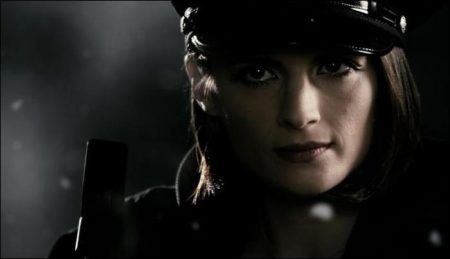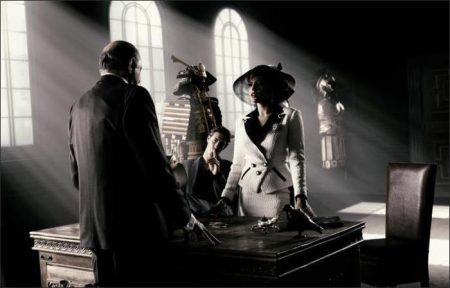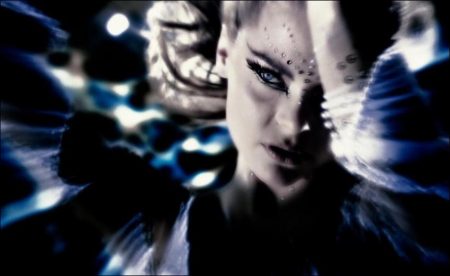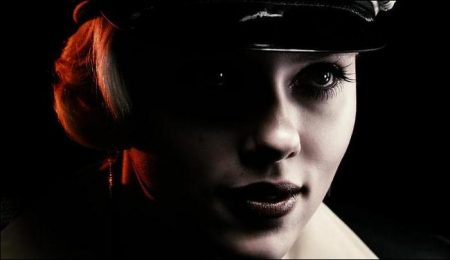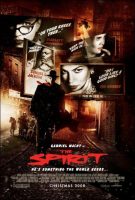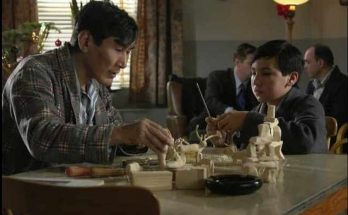The Spirit brings together two visionaries in the art of graphic storytelling: Frank Miller, the creator of such edgy contemporary classics as “Sin City,” “300,” and “The Dark Knight Returns”; and Will Eisner, a pioneer of the modern American comic book. Eisner broke the comic book mold when he introduced “The Spirit” in 1940; now Miller achieves a similar feat with The Spirit, a comic book movie that looks like no other before it.
Miller cites Eisner as one of his greatest and earliest inspirations. “I first encountered Will Eisner’s comics when I was 13 years old, and I thought he was the hot new guy,” Miller reports. “The work was about 40 years old but it looked fresher and newer than anything I’d seen before.”
Eisner was barely into his 20s and already at the forefront of the new comic book movement when he created “The Spirit” as a weekly, stand-alone newspaper insert. The series not only accelerated the comic’s artistic evolution from the three and four-panel strips of the “funny pages,” it became the incubator for a host of formal and narrative innovations. While invincible costumed crusaders like Batman and Superman were making waves, Eisner created a masked hero in a suit, tie, gloves and fedora, with no superhuman powers to his credit.
He was neither millionaire nor alien, just a onetime cop named Denny Colt widely believed to be dead. The Spirit was very much an adult character, with a wry sense of humor, an eye for the ladies, and an unswerving devotion to Central City, the gritty urban melting pot he called home. And Eisner chronicled his adventures with a cinematic sense of style, in illustrations that evoked the stark compositions and unusual spatial perspectives of works like Citizen Kane.
Miller had begun working in comic books when he met Eisner for the first time, at a party in New York City. “I was writing and drawing one of my first issues of `Daredevil’ for Marvel Comics,” he recalls. “Eisner took a look at the opening page and immediately told me what was wrong with it. We started arguing about the use of the caption on it, and that began a debate that ran for 25 years about how to make comics and how they work. We had a very fiery, healthy relationship and a very dear friendship. I learned a lot from him.”
Keeping True to “The Spirit”
Producers Deborah Del Prete and Michael E. Uslan are both lifelong comics enthusiasts. In 1992, Uslan, who helped usher in the modern era of adult-themed comic movies when he produced Tim Burton’s Batman (1989), acquired the rights to The Spirit from Eisner. In making the deal with Eisner, Uslan recalls that he made a simple, sincere promise: “I swore to Will that nobody would touch The Spirit — not a company, not a person — unless they were willing to respect the property and do it the right way.”
Almost a decade later, actor Dan Lauria introduced Uslan to Del Prete and her producing partner Gigi Pritzker. Del Prete was intrigued when she learned of Uslan’s background in comic book properties. “I said to Michael, `Look, I’ve wanted to make a comic book movie,’” Del Prete recalled. `We’re independent filmmakers. We can develop things on our own. I’ve been looking for that kind of movie.’”
Uslan did not see the Odd Lot folks for a long time after. When he was still frustrated in his “Spirit” quest, he went to meet with Del Prete in 2004, determined to make his “Spirit” pitch. “We had a lovely conversation and then she said, `You finally brought me something! What did you bring me?’,” he remembers. “I said, `Deb, I’m bringing you the greatest creative work to ever come out of the comic book industry in the last 70 years.’ She looked at me and said, `Don’t tell me you have the rights to `The Spirit?’ And I looked up into the sky and I said, `Mama, I’m home!’ She was the first person who knew about `The Spirit!’ It was a magic moment.”
Comments Del Prete, “Comic books are how I learned to tell a story in pictures. I’ve wanted to make a comic book movie, but not just any one. I’ve always thought `The Spirit’ was a brilliant creation, and so I was very excited to produce this movie.”
Frank Miller was on Odd Lot’s A-list as a potential writer for a `Spirit’ movie. In many ways, Miller was an inheritor of Eisner’s mantle and Del Prete and Pritzker were determined to seek him out. When Eisner died in January 2005 at the age of 87, they asked Uslan, who would be attending the memorial in placeCityNew York City along with Miller, to approach him about writing and directing The Spirit. At first, Miller demurred – how could he touch the work of the master, his friend and mentor? Miller walked away, but he soon called back with the words The Spirit production wanted to hear: “I can’t let anyone else touch it.”
Miller’s commitment added an even greater sense of occasion to The Spirit As Del Prete explains it, “You have Will Eisner, literally one of the creators of comics. Then you have the man who is the absolute leading icon of comics today, Frank Miller – who was Will’s protégé, peer, friend and battle-partner. That’s a coup.”
About the Screenplay
Miller surrounded himself with panels of Eisner’s artwork as he set to work on the script. “I originally thought in terms of a novelist, a Raymond Chandler, and I was going to do that kind of narrative,” says the writer / director. “But I discovered that placeCityChandler was the completely wrong reference, that Eisner was much more of an O. Henry. He told a series of little short stories, many of which were quite beautiful. I decided to pick my favorite, a two-parter about Sand Saref, and expand from that.”
Sexy international jewel thief Sand Saref is one of the many lovely ladies Eisner created in “The Spirit.” Among the other seductresses and sweethearts who found their way into Miller’s narrative are Ellen Dolan, daughter of Central City’s police commissioner, the exotic chanteuse Plaster of Paris, the icy genius Silken Floss and the underwater angel of death Lorelei. “What I wanted to capture in The Spirit was implicit in Eisner’s work,” explains Miller. “The Spirit himself was a bit of a cad. While he had Ellen Dolan as his sweetheart, he had such an eye for the ladies. But the true love of his life is Central City, and she’s always there to be his real soul-mate.”
The Spirit puts himself on the line for his city, and Eisner often subjected his hero to all manner of physical injuries at the hands of his foes. The Spirit’s ability to take a punch – and then some – became a central theme of Miller’s plot. “The Spirit knows that he is a cop who was shot dead and mysteriously came back to life and he has no idea how,” Miller states. “He’s not a superhero. He can’t fly, he can’t throw cars around. But he has this one extraordinary quality: he can take ridiculous amounts of punishment, and heal faster than anybody. So in the midst of this romantic adventure, he’s on an existential journey to find out what he really is.”
The answer to that question, Miller decided, lay with the Octopus, one of Eisner’s iconic villains. In the original series, the Octopus was represented solely by a pair of white gloves. Miller decided to show the character in his entirety, reinventing him as a resentful Central City coroner who finances his twisted genetic experiments through a lucrative drug trade. In grand comic book style, the Octopus is the Spirit’s polar opposite. “As the Spirit brings order to the world, the Octopus brings chaos. As the Spirit seeks to help people, the Octopus seeks to enslave them,” Miller affirms, adding, “He’s also categorically nuts.”
Eisner always wrote his hero to be contemporary, and Miller followed that example in writing The Spirit. However, Miller added his own twist to the notion of “contemporary,” fashioning a story that mixes design elements from several different eras. Thus, The Spirit unfolds against a landscape where women are dressed to the nines, men wear suits and hats, and taxicabs are elegant sedans from the 50s. It’s also a world of cell phones, flak jackets and cloning. The film’s adventures have a level of grittiness and violence that says 21st Century, rather than 1940s. Meanwhile, the irreverent humor that was an intrinsic part of Eisner’s universe is fully accounted for, and seasoned with Miller’s characteristic mordancy.
Producer Del Prete was a key collaborator during the months Miller spent shaping and refining the screenplay. “The tone of the script is what I think the tone of the comics was. It’s an adventure, it’s a romance, but there’s a lot of humor in it as well,” she says. “We were always very careful to respect the elements of `The Spirit’ that are Eisner traditions. That said, he is Frank Miller and he brings his own specific point of view.”
Pritzker, a newcomer to the world of comic books, served as a proxy for the general moviegoer with no prior knowledge of “The Spirit,” Will Eisner or Frank Miller. “It was important that The Spirit be accessible to people who weren’t necessarily insiders to the comic book world,” Pritzker states. “And I think it is. It’s got great inside jokes for those who are really familiar — but for those of us who aren’t, it’s a fantastic story, and very funny.”
The Spirit (2008)
Directed by: Frank Miller
Starring: Gabriel Macht, Samuel L. Jackson, Scarlett Johansson, Eva Mendes, Sarah Paulson, Paz Vega, Jamie King, Dan Lauria, Stana Katic, Seychelle Gabriel, Frank Miller, Michael Milhoan
Screenplay by: Frank Miller
Cinematography by: Bill Pope
Film Editing by: Gregory Nussbaum
Costume Design by: Michael Dennison, Mark Zunino
Set Decoration by: Gabrielle Petrissans
Art Direction by: Rosario Provenza
Music by: David Newman
MPAA Rating: PG-13 for intense sequences of stylized violence and action, some sexual content and brief nudity.
Distributed by: Lionsgate Films
Release Date: December 25, 2008
Views: 103
